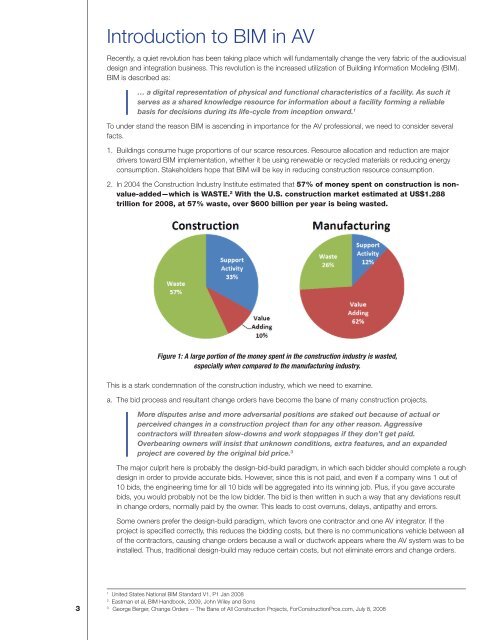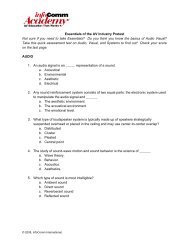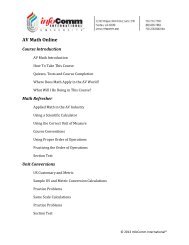Building Information Modeling (BIM) - InfoComm International
Building Information Modeling (BIM) - InfoComm International
Building Information Modeling (BIM) - InfoComm International
You also want an ePaper? Increase the reach of your titles
YUMPU automatically turns print PDFs into web optimized ePapers that Google loves.
3<br />
Introduction to <strong>BIM</strong> in AV<br />
Recently, a quiet revolution has been taking place which will fundamentally change the very fabric of the audiovisual<br />
design and integration business. This revolution is the increased utilization of <strong>Building</strong> <strong>Information</strong> <strong>Modeling</strong> (<strong>BIM</strong>).<br />
<strong>BIM</strong> is described as:<br />
… a digital representation of physical and functional characteristics of a facility. As such it<br />
serves as a shared knowledge resource for information about a facility forming a reliable<br />
basis for decisions during its life-cycle from inception onward. 1<br />
To under stand the reason <strong>BIM</strong> is ascending in importance for the AV professional, we need to consider several<br />
facts.<br />
1. <strong>Building</strong>s consume huge proportions of our scarce resources. Resource allocation and reduction are major<br />
drivers toward <strong>BIM</strong> implementation, whether it be using renewable or recycled materials or reducing energy<br />
consumption. Stakeholders hope that <strong>BIM</strong> will be key in reducing construction resource consumption.<br />
2. In 2004 the Construction Industry Institute estimated that 57% of money spent on construction is nonvalue-added—which<br />
is WASTE. 2 With the U.S. construction market estimated at US$1.288<br />
trillion for 2008, at 57% waste, over $600 billion per year is being wasted.<br />
Figure 1: A large portion of the money spent in the construction industry is wasted,<br />
especially when compared to the manufacturing industry.<br />
This is a stark condemnation of the construction industry, which we need to examine.<br />
a. The bid process and resultant change orders have become the bane of many construction projects.<br />
More disputes arise and more adversarial positions are staked out because of actual or<br />
perceived changes in a construction project than for any other reason. Aggressive<br />
contractors will threaten slow-downs and work stoppages if they don’t get paid.<br />
Overbearing owners will insist that unknown conditions, extra features, and an expanded<br />
project are covered by the original bid price. 3<br />
The major culprit here is probably the design-bid-build paradigm, in which each bidder should complete a rough<br />
design in order to provide accurate bids. However, since this is not paid, and even if a company wins 1 out of<br />
10 bids, the engineering time for all 10 bids will be aggregated into its winning job. Plus, if you gave accurate<br />
bids, you would probably not be the low bidder. The bid is then written in such a way that any deviations result<br />
in change orders, normally paid by the owner. This leads to cost overruns, delays, antipathy and errors.<br />
Some owners prefer the design-build paradigm, which favors one contractor and one AV integrator. If the<br />
project is specified correctly, this reduces the bidding costs, but there is no communications vehicle between all<br />
of the contractors, causing change orders because a wall or ductwork appears where the AV system was to be<br />
installed. Thus, traditional design-build may reduce certain costs, but not eliminate errors and change orders.<br />
1 United States National <strong>BIM</strong> Standard V1, P1 Jan 2008<br />
2 Eastman et al, <strong>BIM</strong> Handbook, 2009, John Wiley and Sons<br />
3 George Berger, Change Orders -- The Bane of All Construction Projects, ForConstructionPros.com, July 8, 2008

















